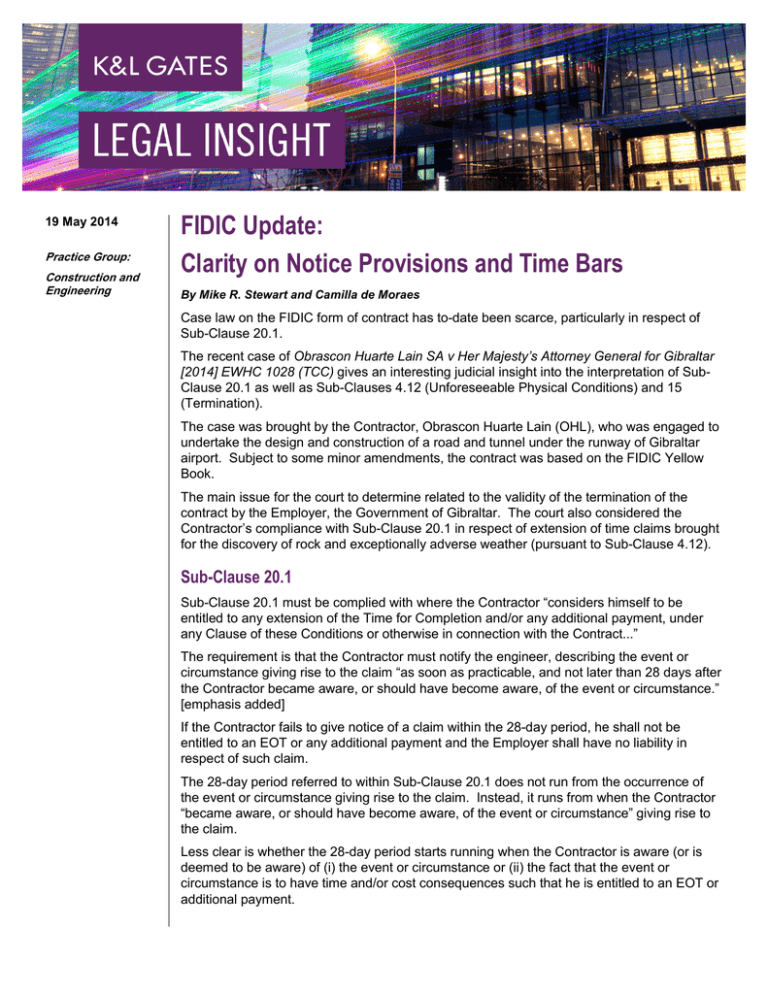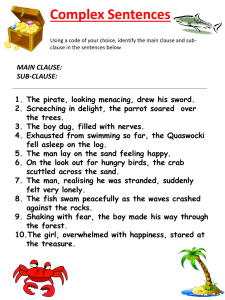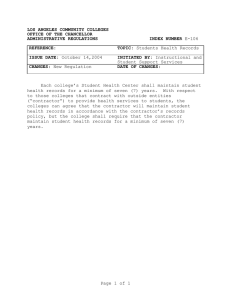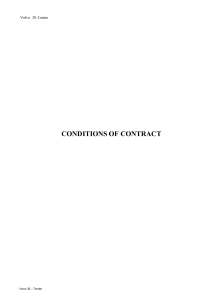
19 May 2014
Practice Group:
Construction and
Engineering
FIDIC Update:
Clarity on Notice Provisions and Time Bars
By Mike R. Stewart and Camilla de Moraes
Case law on the FIDIC form of contract has to-date been scarce, particularly in respect of
Sub-Clause 20.1.
The recent case of Obrascon Huarte Lain SA v Her Majesty’s Attorney General for Gibraltar
[2014] EWHC 1028 (TCC) gives an interesting judicial insight into the interpretation of SubClause 20.1 as well as Sub-Clauses 4.12 (Unforeseeable Physical Conditions) and 15
(Termination).
The case was brought by the Contractor, Obrascon Huarte Lain (OHL), who was engaged to
undertake the design and construction of a road and tunnel under the runway of Gibraltar
airport. Subject to some minor amendments, the contract was based on the FIDIC Yellow
Book.
The main issue for the court to determine related to the validity of the termination of the
contract by the Employer, the Government of Gibraltar. The court also considered the
Contractor’s compliance with Sub-Clause 20.1 in respect of extension of time claims brought
for the discovery of rock and exceptionally adverse weather (pursuant to Sub-Clause 4.12).
Sub-Clause 20.1
Sub-Clause 20.1 must be complied with where the Contractor “considers himself to be
entitled to any extension of the Time for Completion and/or any additional payment, under
any Clause of these Conditions or otherwise in connection with the Contract...”
The requirement is that the Contractor must notify the engineer, describing the event or
circumstance giving rise to the claim “as soon as practicable, and not later than 28 days after
the Contractor became aware, or should have become aware, of the event or circumstance.”
[emphasis added]
If the Contractor fails to give notice of a claim within the 28-day period, he shall not be
entitled to an EOT or any additional payment and the Employer shall have no liability in
respect of such claim.
The 28-day period referred to within Sub-Clause 20.1 does not run from the occurrence of
the event or circumstance giving rise to the claim. Instead, it runs from when the Contractor
“became aware, or should have become aware, of the event or circumstance” giving rise to
the claim.
Less clear is whether the 28-day period starts running when the Contractor is aware (or is
deemed to be aware) of (i) the event or circumstance or (ii) the fact that the event or
circumstance is to have time and/or cost consequences such that he is entitled to an EOT or
additional payment.
FIDIC Update: Clarity on Notice Provisions and Time Bars
In his judgement, Mr Justice Akenhead saw no reason why Clause 20.1 should be construed
strictly against the Contractor, especially given the serious consequences of such an
approach, namely that the Contractor would lose entitlement to what otherwise might be a
good claim against the Employer.
Mr Justice Akenhead, in reaching his decision, made reference to Sub-Clause 8.4 of the
FIDIC conditions, which sets out the circumstances in which the Contractor is entitled to an
extension of time. Sub-Clause 8.4 states that:
“The Contractor shall be entitled subject to Sub-Clause 20.1...to an extension of the Time for
Completion if and to the extent that the completion for the purposes of Sub-Clause 10.1...is
or will be delayed by any of the following causes...” [emphasis added]
The judge placed particular emphasis on the words identified in bold in the paragraph above.
He stated that the entitlement to an extension clearly arises either when it is clear that there
will be a delay (a prospective delay) or when the delay has at least started to be incurred (a
retrospective delay). From this, he concluded that notice does not have to be given until
there actually is a delay. Whilst of course the Contractor can give notice when it reasonably
believes that it will be delayed, it is not required to do so. Sub-Clause 8.4 grants the
Contractor the choice by virtue of the word “or” between “is” and “will be.” If the Contractor
was required to give notice on the earlier date, the wording of Sub-Clause 8.4 would have
read “is or will be delayed whichever is the earliest” [emphasis added].
Further, the judge held that whilst there is no particular form of notice required pursuant to
Sub-Clause 20.1, it must be recognisable as a “claim”. In this case, OHL had tried to rely on
a monthly progress report which stated that “The adverse weather condition (rain) have [sic]
affected the works” to constitute the requisite notice for an extension of time. In the judge’s
view, this was “clearly nowhere near a notice under Clause 20.1.”
Mr Justice Akenhead confirmed that the onus is on the Employer to establish that a notice is
not given in time. In any event, in this particular case, OHL failed to give notice of the
exceptionally adverse weather within the 28-day period and, therefore, was only entitled to a
one-day extension to the Time for Completion.
Sub-Clause 4.12 (Unforeseeable Physical Conditions)
The court, in determining whether OHL had encountered unforeseeable physical conditions,
was required to consider the ground conditions that were reasonably foreseeable by an
experienced Contractor at the date of the submission of the tender. OHL had been provided
with site data, and had been told to allow for a substantial volume of contaminated material,
but had not done so.
The court held that OHL should have carried out “some intelligent assessment and analysis”
of why the site was contaminated and what the real risk was of encountering more
contaminated material than had been envisaged at the tender stage. OHL had failed to do
so and, therefore, its claims were rejected.
Sub-Clause 15 (Termination)
The court also had to consider whether the Employer had lawfully terminated the contract
with OHL. Sub-Clause 15 provides that the Employer is entitled to terminate the contract if
the Contractor (having been given notice) does not rectify a failure to carry out any obligation
2
FIDIC Update: Clarity on Notice Provisions and Time Bars
under the contract. The court held that Sub-Clause 15 is generally to be construed as
permitting termination for significant or substantial breaches, rather than trivial or insignificant
ones, but rejected OHL’s argument that the breach relied upon must be equivalent to a
repudiatory breach of contract.
The court ultimately found in the Employer’s favour with regards to the lawfulness of the
termination. Amongst other things, this was on the basis that OHL failed to progress the
Works with due expedition, thereby breaching Clause 8.1 of the Contract. This allowed the
Employer to terminate under 15.2(c) and recover all costs associated with the termination
and completion costs, insofar as the same exceeded OHL’s original contract price. The
award is likely to be the largest ever awarded to the Government of Gibraltar and will,
therefore, have significant economic consequences, not least that it should be able to finalise
the works commenced by OHL and have a working tunnel under the runway.
Conclusion
This recent case provides welcome clarity with respect to a number of matters.
Most importantly it highlights that, under Sub-Clause 20.1 of the FIDIC conditions, the clock
does not start running for the Contractor until the date on which he is aware (or should have
been aware) of the delay resulting from a particular event or circumstance. Although the
court only considered Sub-Clause 20.1 in respect of an extension of time, the same principle
is expected to apply to claims for additional payment made pursuant to this provision.
Claims made pursuant to Sub-Clause 20.1 must be identifiable as claims, with a description
of the event or circumstance relied on, and must state that the notice is intended to notify a
claim for an extension of time or additional payment under the contract. A passing reference
to a particular event will not, on its own, be sufficient. However, it is important to note that
whilst this judgment is likely to be viewed as positive for Contractors, it is certainly not carte
blanche for the Contractor to disregard the notice provisions all together. He still has to
comply with the 28-day period; it simply starts a little later.
Authors:
Mike R. Stewart
mike.stewart@klgates.com
+44.(0)20.7360.8141
Camilla A. de Moraes
camilla.demoraes@klgates.com
+44.(0)20.7648.9000
Anchorage Austin Beijing Berlin Boston Brisbane Brussels Charleston Charlotte Chicago Dallas Doha Dubai Fort Worth Frankfurt
Harrisburg Hong Kong Houston London Los Angeles Melbourne Miami Milan Moscow Newark New York Orange County Palo Alto Paris
Perth Pittsburgh Portland Raleigh Research Triangle Park San Diego San Francisco São Paulo Seattle Seoul Shanghai Singapore Spokane
Sydney Taipei Tokyo Warsaw Washington, D.C. Wilmington
3
FIDIC Update: Clarity on Notice Provisions and Time Bars
K&L Gates practices out of 48 fully integrated offices located in the United States, Asia, Australia, Europe, the
Middle East and South America and represents leading global corporations, growth and middle-market companies,
capital markets participants and entrepreneurs in every major industry group as well as public sector entities,
educational institutions, philanthropic organizations and individuals. For more information about K&L Gates or its
locations, practices and registrations, visit www.klgates.com.
This publication is for informational purposes and does not contain or convey legal advice. The information herein should not be used or relied upon in
regard to any particular facts or circumstances without first consulting a lawyer.
© 2014 K&L Gates LLP. All Rights Reserved.
4





